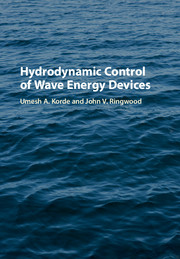Book contents
- Frontmatter
- Contents
- Preface
- Acknowledgments
- Part I Introduction
- Part II The Basics
- Part III The Hydrodynamics
- Part IV Velocity Control Using a Hydrodynamic Model
- Part V Control by Optimizing a Performance Index
- Part VI Toward Overall WEC System Hydrodynamic Optimization
- Part VII In Closing
- References
- Index
Part IV - Velocity Control Using a Hydrodynamic Model
Published online by Cambridge University Press: 05 September 2016
- Frontmatter
- Contents
- Preface
- Acknowledgments
- Part I Introduction
- Part II The Basics
- Part III The Hydrodynamics
- Part IV Velocity Control Using a Hydrodynamic Model
- Part V Control by Optimizing a Performance Index
- Part VI Toward Overall WEC System Hydrodynamic Optimization
- Part VII In Closing
- References
- Index
Summary
In this part, we examine the control problem based on the fundamentals of the hydrodynamic model. In particular, Chapter 7 uses Cummins’ equation as a starting point and develops the classic reactive control strategy leading to a velocity response that approaches the hydrodynamic velocity optimum. Chapter 7 also addresses the issue of the requirement for future wave elevation information and discusses two possible ways to utilize up-wave measurements for this purpose. One uses instantaneous up-wave measurements at a distance related to the prediction time ahead and assumes nondispersive propagation. The second accounts for dispersive propagation and uses up-wave measurements made over a duration of time and at a distance, both of which are directly related to the practical range of group velocities commonly found in wave spectra and the prediction time ahead. Chapter 8 uses a simplified hydrodynamic model, motivated by the idea that, while offering some compromise in performance, less detail in the model may offer improved robustness properties. The method proposed in Chapter 8 addresses the issue of future information by modeling the wave spectrum as a narrow-banded process, where an extended Kalman filter is used to make instantaneous measurements of wave period and amplitude. The control method can cater to device amplitude constraints, and a possible lower-level power take-off controller is presented.
- Type
- Chapter
- Information
- Hydrodynamic Control of Wave Energy Devices , pp. 149 - 150Publisher: Cambridge University PressPrint publication year: 2016



